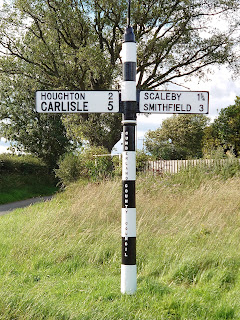Black and White Roadsigns
History is all around us and the evidence is often so obvious that we don't really take it in, we don't realise it's there. From the ridge and furrow in the fields to the farm cottages near our house, they all tell of times past.
I am still out on my bike, cycling to work along the lanes of North Cumbria. Whilst out recently, I noticed that a nearby black and white finger post had been dismantled and the directional arms of the post had been taken away. The next time I went past, the main post had been painted and I noticed the lettering down the post 'Cumberland County Council', a county name long since gone. Red tape cordened off the area around the post for a few weeks as I waited for the return of the directional arms. It seemed to take ages, and to be honest I started to lose interest and forget about it.
But on my way home from work last week, I sailed down the hill and to my surprise, the post was complete. It looked glorious in the sunshine with its new coat of paint, standing loud and proud on the roadside. The post is situated on a T- junction opposite a farm, and is located about a mile from my house. Of course I had to stop and photograph it.
I would love to know why these old fashioned sign posts are still in existence in Cumbria. During the Second World War signposts like these were removed due to the threat of German parachutists landing in the UK, returned to their location when hostilities were over. I might venture to the Archives when things start to return to normal, and try and to find out more. I want to know how are these posts still here? Why have they not been replaced by more modern signposts? Not that I want them replaced. They are a direct connection with the past on our highways and byways. Not only that, but their regal presence along the country lanes are definately preferable to the more modern roadsigns!


Comments
Post a Comment